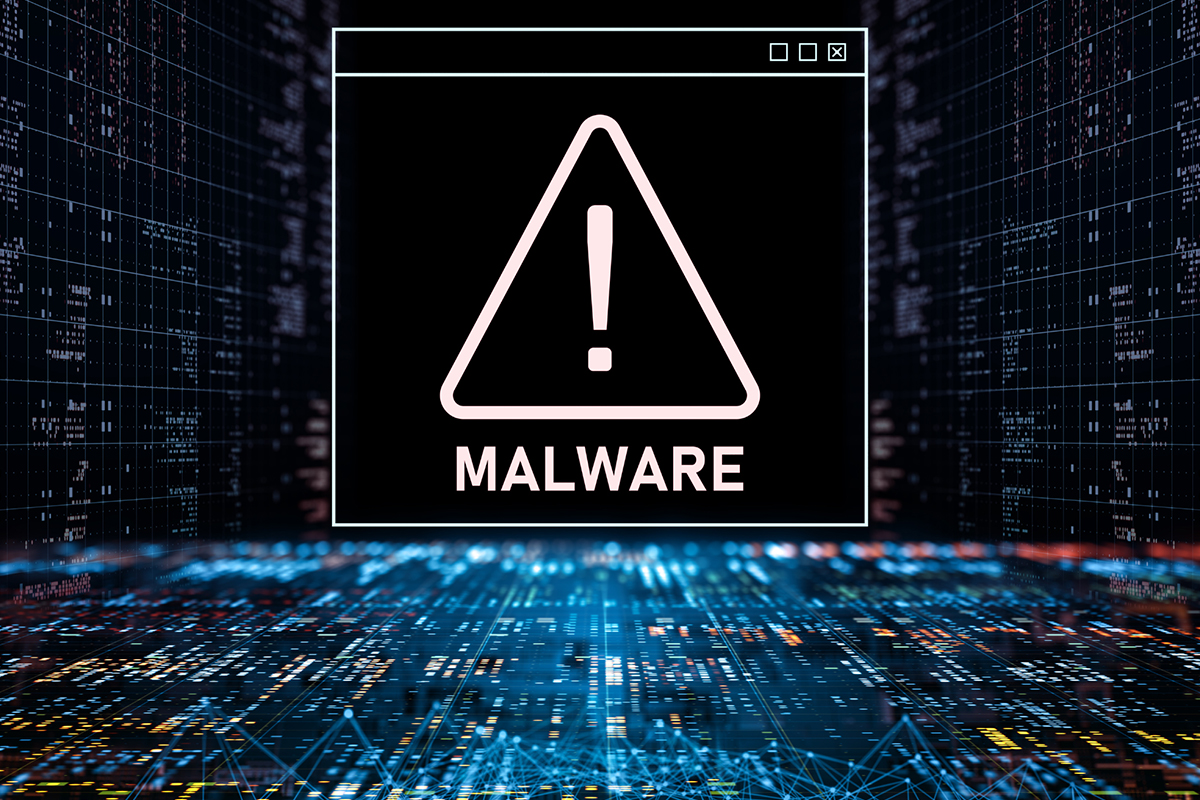7 Advanced Malware Threats Businesses Can’t Ignore in 2025
In 2025, malware has grown far beyond the viruses and worms of the early internet. Today’s threats are stealthier, smarter, and capable of bypassing basic defenses in seconds. And it’s not just large enterprises under attack — small and midsize businesses (SMBs) are now among the most common targets.

The Cost of a Breach
According to IBM’s 2024 Cost of a Data Breach Report, the average breach now costs businesses $4.88 million globally, with SMBs shouldering a growing share of those losses. Beyond financial penalties, breaches often lead to:
- Operational downtime
- Reputation damage
- Legal and compliance exposure
- Customer attrition
And in many cases, these costs result from malware that slipped through outdated antivirus software and went undetected for weeks or even months.
How Malware Has Evolved
Over the past five years, malware has:
- Shifted from file-based to fileless attack vectors
- Adopted polymorphic behavior to evade detection
- Combined with phishing and social engineering tactics
- Targeted mobile devices, cloud apps, and IoT environments
- Used AI to automate and optimize attacks at scale
These changes make traditional defenses like signature-based antivirus tools increasingly obsolete.
SMBs as Prime Targets
Why are smaller businesses increasingly in the crosshairs?
- Lower security budgets make them easier to breach
- Valuable vendor or client access can serve as a gateway to larger targets
- Fewer internal controls make malware more likely to spread unnoticed
If your business hasn’t revisited its security strategy in the last 12–18 months, you could be leaving the door wide open.
1. Polymorphic Malware
Polymorphic malware is designed to change its code every time it executes, making it nearly impossible for traditional antivirus software to detect. These constant mutations help it bypass signature-based scans and intrusion detection systems.
Definition and Behavior
Unlike standard malware that uses static code, polymorphic variants rewrite themselves on the fly, while keeping their core malicious function intact. These shape-shifting threats can:
- Evade detection by creating a new signature with each infection
- Obfuscate their payload until it’s too late
- Spread rapidly across networks using trusted-looking files
This makes them extremely difficult to track, especially for businesses relying on outdated endpoint tools.
Detection Evasion
Polymorphic malware often hides in:
- Email attachments
- Office macros
- Compromised software downloads
- Encrypted web traffic
It may appear harmless to most scanners — until it executes and begins extracting data, installing backdoors, or disabling your protections.
Prevention Tips
To guard against polymorphic threats:
- Use behavior-based detection tools that monitor activity, not just code
- Deploy real-time threat intelligence platforms that recognize patterns of compromise
- Keep systems and security software updated
- Avoid relying on antivirus tools alone
2. Fileless Malware
Unlike traditional malware that relies on malicious files saved to your hard drive, fileless malware operates entirely in memory — making it much harder to detect and nearly impossible for signature-based antivirus tools to catch.
Operation in Memory
Fileless attacks don’t install software in the traditional sense. Instead, they exploit trusted applications (like PowerShell or Windows Management Instrumentation) to run malicious commands directly in your system’s RAM. Once memory is cleared or the system is rebooted, traces of the attack can vanish.
This makes forensic investigation — and prevention — especially difficult.
How It Enters Systems
Common fileless malware delivery methods include:
- Malicious email links triggering scripts
- Compromised websites or watering hole attacks
- Exploit kits that target browser or plugin vulnerabilities
- Phishing attachments that open backdoors via macros
Once inside, attackers can perform credential harvesting, lateral movement across systems, and exfiltration of sensitive data — all without writing a single file to disk.
Tools for Detection
To detect and stop fileless threats, SMBs should:
- Use endpoint detection and response (EDR) solutions that monitor system behavior
- Disable or tightly control scripting tools like PowerShell
- Monitor logs for unusual memory activity or user behavior
- Apply application whitelisting to limit what can run

3. Advanced Ransomware
Ransomware is no longer just about locking your files. In 2025, it’s evolved into a two-stage extortion model that not only encrypts your data but also threatens to leak it publicly if you refuse to pay.
Encryption + Extortion
Modern ransomware campaigns:
- Use military-grade encryption to render files inaccessible
- Exfiltrate sensitive files before encryption
- Threaten public disclosure of data or regulatory fines
- Demand payment in cryptocurrency through anonymized channels
Attackers also target backups to prevent easy recovery — which is why robust, offsite, and segmented backup strategies are more critical than ever.
Industry Targets
Ransomware is hitting SMBs harder than ever, particularly in:
- Healthcare, where access to records is life-critical
- Legal services, where confidentiality is essential
- Construction and manufacturing, where downtime is expensive
- Education, where outdated infrastructure creates easy entry points
Even businesses with fewer than 50 employees are being targeted — often through phishing or remote desktop protocol (RDP) vulnerabilities.
Data Backup Protocols
To defend against ransomware:
- Use immutable backups that can’t be altered or encrypted
- Store at least one backup copy offsite or in a separate cloud instance
- Test your backup restoration process quarterly
- Train employees to spot ransomware delivery attempts
4. Social Engineering Malware
Malware doesn’t always rely on code alone — sometimes, the most effective tactic is human error. Sºocial engineering malware uses psychological manipulation to trick users into taking harmful actions, like clicking infected links or installing disguised software.
Psychology Behind Attacks
Cybercriminals design social engineering schemes to create:
- Urgency: “Your account has been compromised — verify now.”
- Trust: “This is from your boss — please review the attached document.”
- Curiosity: “See photos from the staff party here.”
- Fear: “Your tax filing is overdue — click here to avoid penalties.”
These messages are often carefully crafted to imitate a trusted source, increasing the likelihood that an unsuspecting employee will fall for the bait.
Common Delivery Methods
Social engineering malware is typically delivered through:
- Phishing emails with infected attachments or fake login links
- Smishing (SMS-based phishing) on mobile devices
- Malicious ads on websites (malvertising)
- Impersonation on collaboration platforms (e.g., Slack, Teams)
Once a user engages, malware can be downloaded silently, credentials stolen, or systems compromised.
Employee Training Strategies
To mitigate the threat of social engineering:
- Train employees to recognize phishing, spoofed domains, and suspicious messages
- Encourage a culture of “pause and verify” before clicking links or downloading files
- Use phishing simulations to test and reinforce awareness
- Limit administrative access to reduce impact if a mistake occurs
5. Rootkit Infiltration
Rootkits are one of the most dangerous forms of malware because they are designed to provide deep, unauthorized access to your system while remaining hidden from detection tools.
Hidden Access
Once installed, a rootkit can:
- Alter operating system files
- Hide itself and other malware
- Intercept keystrokes or network activity
- Create backdoors for remote access by attackers
Rootkits operate at a low level, often within the kernel of the OS, which gives them complete control over your system— and makes removal incredibly difficult.
Effects on System Control
If your business is infected with a rootkit, you may experience:
- System slowdowns or strange behavior
- Inability to detect malware using antivirus tools
- Security settings being silently disabled
- Credentials or sensitive data being siphoned undetected
Attackers may retain control of infected systems for months, using them as gateways into broader networks.
Tools to Uncover and Neutralize
Because rootkits evade traditional detection, defense requires:
- Behavior-based monitoring (unusual privilege escalation or traffic)
- Boot-level scanning with specialized tools
- System integrity checks and regular audits
- Rebuilding compromised systems when eradication isn’t guaranteed
6. Spyware Threats
Spyware is one of the most quietly dangerous forms of malware. Unlike ransomware or viruses, it doesn’t crash your system or lock files — instead, it lurks in the background, silently recording every action you take.
Keylogging and Data Capture
Spyware can track:
- Keystrokes, including passwords and credit card info
- Clipboard activity
- Browser history and saved login credentials
- Email content and chat conversations
This information is often sent to attackers who use it to access bank accounts, impersonate employees, or launch broader attacks across your business network.
Entry Points
Spyware often enters systems through:
- Bundled software downloads from unverified sources
- Malicious email attachments disguised as invoices or internal documents
- Drive-by downloads from compromised websites
- Fake updates that appear legitimate
What makes spyware especially concerning for SMBs is that it often goes unnoticed for weeks or months, slowly feeding data back to attackers.
Network Monitoring Solutions
To detect and stop spyware:
- Use network monitoring tools that can flag unusual data transfers or access patterns
- Perform regular scans with advanced anti-malware software
- Restrict installations to approved software only
- Deploy endpoint protection that includes real-time monitoring
7. Trojan Malware
Trojan malware works like a digital Trojan horse — hiding harmful code inside seemingly legitimate files or applications. Once installed, a trojan can deliver additional malware, create backdoors, or give attackers remote control of your device.
Disguised Malicious Programs
Trojans are often disguised as:
- Free utilities or browser plugins
- Software updates
- Documents with embedded macros
- Mobile apps downloaded from unofficial stores
Unlike viruses, trojans don’t replicate themselves — they rely on the user to intentionally install or open them under false pretenses.
Delivery via Phishing
Trojans are frequently delivered via phishing emails. Common tactics include:
- Impersonating vendors or clients to request invoice reviews
- Sending fake shipping updates with attachments
- Masquerading as urgent password reset forms
Once executed, trojans may open ports, disable firewalls, or drop additional malware such as keyloggers, ransomware, or worms.
Endpoint Protection
Protecting your business against trojans requires:
- Advanced endpoint detection and response (EDR)
- Blocking macros from unknown sources
- Restricting user permissions for software installation
- User education on phishing and file hygiene
Why Antivirus Alone Isn’t Enough
Antivirus software still has a role in basic cybersecurity — but in 2025, it’s no longer enough to stand alone. Traditional antivirus relies on signature-based detection, meaning it scans files for known malware patterns. But today’s threats are evolving too quickly.
Limitations of Legacy Tools
Advanced malware now frequently:
- Alters its code (polymorphic malware)
- Avoids files altogether (fileless malware)
- Operates inside trusted applications
- Uses encrypted traffic to hide communications
These techniques bypass basic antivirus tools entirely. Relying on outdated security tools gives your business a false sense of safety — while attackers quietly look for open doors.
The Role of Layered Security
Modern cybersecurity requires a multi-layered approach, including:
- Endpoint detection and response (EDR)
- Email filtering and URL scanning
- Network segmentation and monitoring
- Strong authentication (2FA or beyond)
- Data backup and recovery protocols
It’s not about any one tool — it’s about how all tools work together to identify, isolate, and stop threats.
Real-Time Threat Response
Prevention is critical — but when malware gets through, response time is everything. SMBs without a real-time response plan risk:
- Extended downtime
- Regulatory violations
- Long-term brand damage
Partnering with professionals ensures you contain incidents fast, investigate properly, and reduce exposure.

Proactive Cybersecurity for 2025
Malware isn’t going away — it’s getting more complex, targeted, and persistent. Small businesses must shift from reactive to proactive cybersecurity strategies that anticipate risks before they cause damage.
Managed Detection and Response
Managed detection and response (MDR) combines technology and expertise to:
- Monitor systems 24/7
- Detect threats based on behavior, not just signatures
- Respond immediately to contain breaches
- Continuously update defenses based on emerging threats
If your internal team can’t manage that level of vigilance, an experienced partner like AdvaTech can step in.
Cyber Hygiene Best Practices
Strong defenses also come from strong habits. Build a cybersecurity culture by:
- Requiring software updates across all devices
- Using MFA wherever possible
- Training employees on phishing and scam tactics
- Running frequent internal audits and tests
- Applying least privilege access principles
Cyber hygiene isn’t a one-time fix — it’s a set of habits that reduce your overall risk profile.
Partnering with IT Security Experts
Most SMBs don’t have a dedicated security team. That’s why working with a managed IT provider gives you access to:
- Expert configuration and monitoring
- Enterprise-grade tools without enterprise costs
- Security built to scale with your business
- A fast response team when something goes wrong
Call to Action: Don’t Wait Until Malware Strikes
Your business doesn’t need to be a tech giant to become a malware target. The truth is, most attackers now prefer smaller businesses because they know security is weaker and responses are slower.
AdvaTech Solutions helps you close those gaps before they become expensive problems.
Our cybersecurity services include:
- Endpoint detection and response
- Email threat protection
- Phishing-resistant MFA
- Data backup and disaster recovery
- Ongoing system monitoring and alerting
Schedule a cybersecurity audit or explore our cybersecurity services to see how we can help you detect threats early, respond fast, and stay ahead of the curve.
Cybercrime is evolving — your defenses should be too.
